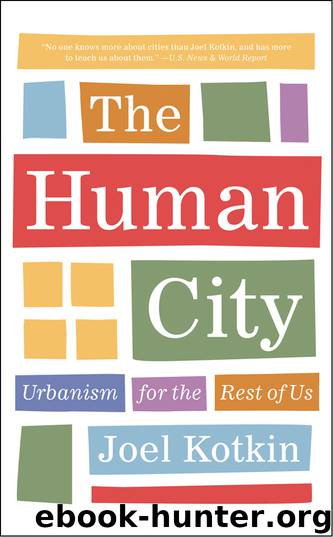The Human City by Kotkin Joel

Author:Kotkin, Joel
Language: eng
Format: epub
ISBN: 978-1-5728-4776-7
Publisher: Agate Publishing
Published: 2016-04-11T16:00:00+00:00
WHY WE NEED BOTH GEOGRAPHIES
Ultimately, urban policy should be about choices, and developers should respond to market signals and preferences rather than government edicts that suggest how people should live. If people choose to move into the city and the market supports it, that, too, should be encouraged.
But the notion that development be “steered” into ever-denser pockets violates, as we’ve seen, the wishes of the vast majority. These attitudes reflect a remarkable degree of disrespect and even contempt toward the choices people make. If people move to the periphery, it is not because they are deluded or persuaded by advertising but because they perceive that is where their quality of life is higher.178
As we’ve seen, suburban and urban expansion are nothing new. New archeological evidence points to the earliest cities being formed by combining several discrete small communities; even the ancient Maya had what researchers described as “urban sprawl,” complete with large houses and even an archaic version of strip malls. For his part, Aristotle spoke about cities as the union of “several villages.” Suburbs and small communities are not new phenomena but instead are woven into the history of urban life.179
Rather than demonizing and belittling the suburbanite, urbanists would be far better off taking a more human-city approach and focusing on how to improve life not only in the city cores but also in extensive areas that have developed around them. As American sociologist Herbert Gans noted:
I have never seen any persuasive evidence that sprawl has significant bad effects, or high-density development significant virtues. Indeed I doubt that density itself has much impact on people, except at levels which create overcrowding or isolation. I therefore believe that people should be able to choose the density levels they prefer. Since most Americans who are able to choose have long preferred low-density housing, I favor urban policies that respect that preference, while not ignoring the minority preferring high-rise housing.180
This is not to say that dense urbanity is bad, for it is not, but it simply does not fit the needs of much of the population, particularly as they enter their 30s and 40s. The real issue here is not the urban form but what locales best provide a better life for most citizens. What is needed now is recognition that cities need to nurture both geographies—the largely childless inner districts and those areas likely to attract middle-class families: the suburbs and less dense urban neighborhoods. Cities can be ideal for younger people and those in the early stages of their careers. For them, living in a dense city might actually prove more healthful due to both the greater prevalence of walking or biking and the stimulation that comes from city life. It also can appeal to a small but significant population of empty nesters, childless couples, and the super-affluent, who can afford the blessings offered by dense urbanity.
The notion that suburban, or dispersed, living is something to be limited—or even banned as fundamentally unhealthy—ultimately deprives the city of both an alternative for its maturing citizenry and a future source of young people.
Download
This site does not store any files on its server. We only index and link to content provided by other sites. Please contact the content providers to delete copyright contents if any and email us, we'll remove relevant links or contents immediately.
The Secret History by Donna Tartt(16606)
The Social Justice Warrior Handbook by Lisa De Pasquale(11485)
Thirteen Reasons Why by Jay Asher(7780)
This Is How You Lose Her by Junot Diaz(5753)
Weapons of Math Destruction by Cathy O'Neil(5029)
Zero to One by Peter Thiel(4816)
The Myth of the Strong Leader by Archie Brown(4785)
Promise Me, Dad by Joe Biden(4440)
Stone's Rules by Roger Stone(4412)
Beartown by Fredrik Backman(4403)
How Democracies Die by Steven Levitsky & Daniel Ziblatt(4392)
The Fire Next Time by James Baldwin(4336)
100 Deadly Skills by Clint Emerson(4070)
A Higher Loyalty: Truth, Lies, and Leadership by James Comey(4024)
Rise and Kill First by Ronen Bergman(4008)
The David Icke Guide to the Global Conspiracy (and how to end it) by David Icke(3875)
The Farm by Tom Rob Smith(3869)
Secrecy World by Jake Bernstein(3773)
The Doomsday Machine by Daniel Ellsberg(3725)
